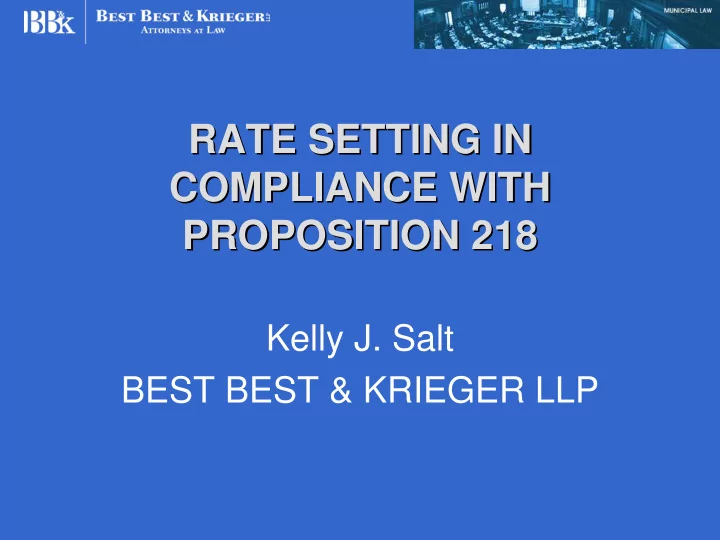

RATE SETTING IN RATE SETTING IN COMPLIANCE WITH COMPLIANCE WITH PROPOSITION 218 PROPOSITION 218 Kelly J. Salt BEST BEST & KRIEGER LLP
Proposition 218 (1996) Proposition 218 (1996) • Expanded restrictions on government spending • Allowed voters to repeal or reduce taxes, assessments, fees, and charges by initiative process
Procedural Requirements: Notice Procedural Requirements: Notice • The Amount of the fee or charge • The basis upon which the fee or charge was calculated • The reason for the fee or charge • The date, time and location of the public hearing
Procedural Requirements: Procedural Requirements: Public Hearing Public Hearing Section 6(a)(2) - the public hearing must not be held less than 45 days after the mailing of the notice; agency shall not impose the new fee or increase to the existing fee if it receives written protests from a majority of property owners
Substantive Requirements: Substantive Requirements: Article XIII D, § 6(b) Article XIII D, § 6(b) California Constitution article XIII D, § 6(b) established substantive requirements: –Fees shall not exceed the reasonable cost of providing the service –Fees shall not exceed the proportional cost of providing the service attributable to the parcel on which it is imposed
Substantive Requirements: Substantive Requirements: Article XIII D, § 6(b) Article XIII D, § 6(b) –Revenues from the fee shall not be used for any other purpose than that for which is was imposed –No fee may be charged unless the service is immediately available to the property –No fee may be imposed for general governmental purposes where the service is available to the public at large in substantially the same manner
California Constitution article X, § 2 2 California Constitution article X, § The general welfare requires that the water resources of the State be put to beneficial use to the fullest extent of which they are capable, and that the waste or unreasonable use of water be prevented
California Water Code §§ 100 & 106 California Water Code §§ 100 & 106 • Section 100 – Restates California Constitution article X, section 2 • Section 106 – The use of water for domestic purposes is the highest use of water and the next highest use is for agriculture
Other Water Code Sections Other Water Code Sections • Water Code sections 520-529.7 • Water Code section 370 • Water Code section 1009 • Water Code section 10631(f) • Water Code section 10608 • Proposition 204 (Water Code section 78500.2)
Water Code § 375 Water Code § 375 Encourage water conservation and resource management through rate structure design
Water Resource Management Water Resource Management through Rate Design through Rate Design • Adopting inclining block rates • Adopting inclining block rates with water budgets • Impose fines or penalties
Water Resource Management Water Resource Management through Rate Design through Rate Design • Allocation-based water pricing (aka water budgets) – Water Code section 370 et seq. • Provide volumetric allotments of water –Establish allocations for basic water use –Create price points to deter waste and encourage efficiency
Water Resource Management Water Resource Management through Rate Design through Rate Design • Those who stay within their allocations are not wasting water • Allocations may be customized
Water Resource Management Water Resource Management through Rate Design through Rate Design • Brydon v. East Bay Municipal Utility District (1994) 24 Cal. App. 4 th 178 –Inclining block rate structure challenged as invalid tax –Court held the rate structure was designed in response to constitutionally mandated water resource conservation requirements
Water Resource Management Water Resource Management through Rate Design through Rate Design –Article XIII A was not intended to subvert Article X, section 2 –Allocate costs based on unreasonable use –Same principles apply to Article XIII D, section 6
Water Resource Management Water Resource Management through Rate Design through Rate Design Shifting the costs of environmental degradation from the general public to those most responsible is consistent with the objectives of Proposition 13
Water Resource Management Water Resource Management through Rate Design through Rate Design • Establish proportionality and cost-revenue nexus requirements through tiers – Conservation costs – Water resource management costs
Harmonizing Article X and Article XIII D Harmonizing Article X and Article XIII D • Courts will “harmonize” constitutional provisions to avoid conflict and avoid repeal – Silicon Valley Taxpayers Ass’n v. Santa Clara Open Space Authority – Greene v. Marin County Flood Control & Water Conservation District
City of Palmdale v. City of Palmdale v. Palmdale Water District Palmdale Water District • District adopted allocation based water rates pursuant to Water Code section 370 to promote water conservation • City, an irrigation customer, challenged the fees for failing to meet the proportionality requirements of Article XIII D, § 6(b)
City of Palmdale v. City of Palmdale v. Palmdale Water District Palmdale Water District • Two components to rates – Fixed monthly charge – Commodity charge • Incremental rate increase depended on customer’s rate classification
City of Palmdale v. City of Palmdale v. Palmdale Water District Palmdale Water District • Budget based water rates and tiered rate structures do not violate Proposition 218 • However, the district failed to demonstrate that the proposed budget based rates for one customer class were proportionate
Rates and Proportionality Rates and Proportionality “The question of proportionality is not measured on an individual basis. Rather it is measured collectively, considering all ratepayers. Thus, permissible fees must be related to the overall cost of the governmental regulation. They need not be finely calibrated to the precise benefit each individual fee payor might derive”
Conclusion Conclusion • The California Constitution mandates that water shall not be wasted or used unreasonably • The California Constitution mandates that water service fees shall be proportionate to the cost of providing the service • Tiered water rates are fully consistent with both of these Constitutional mandates
Questions ? ? Questions
Recommend
More recommend